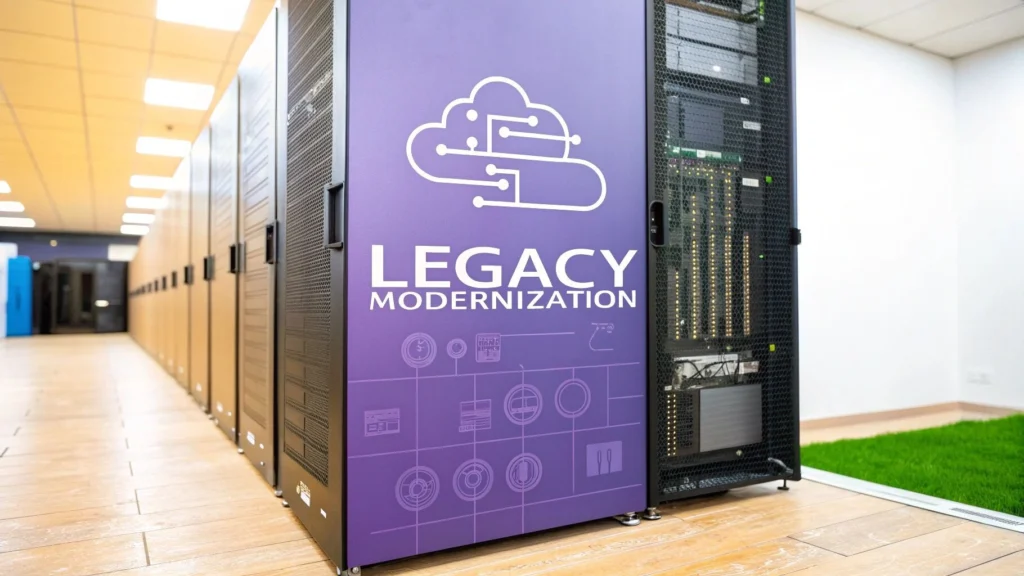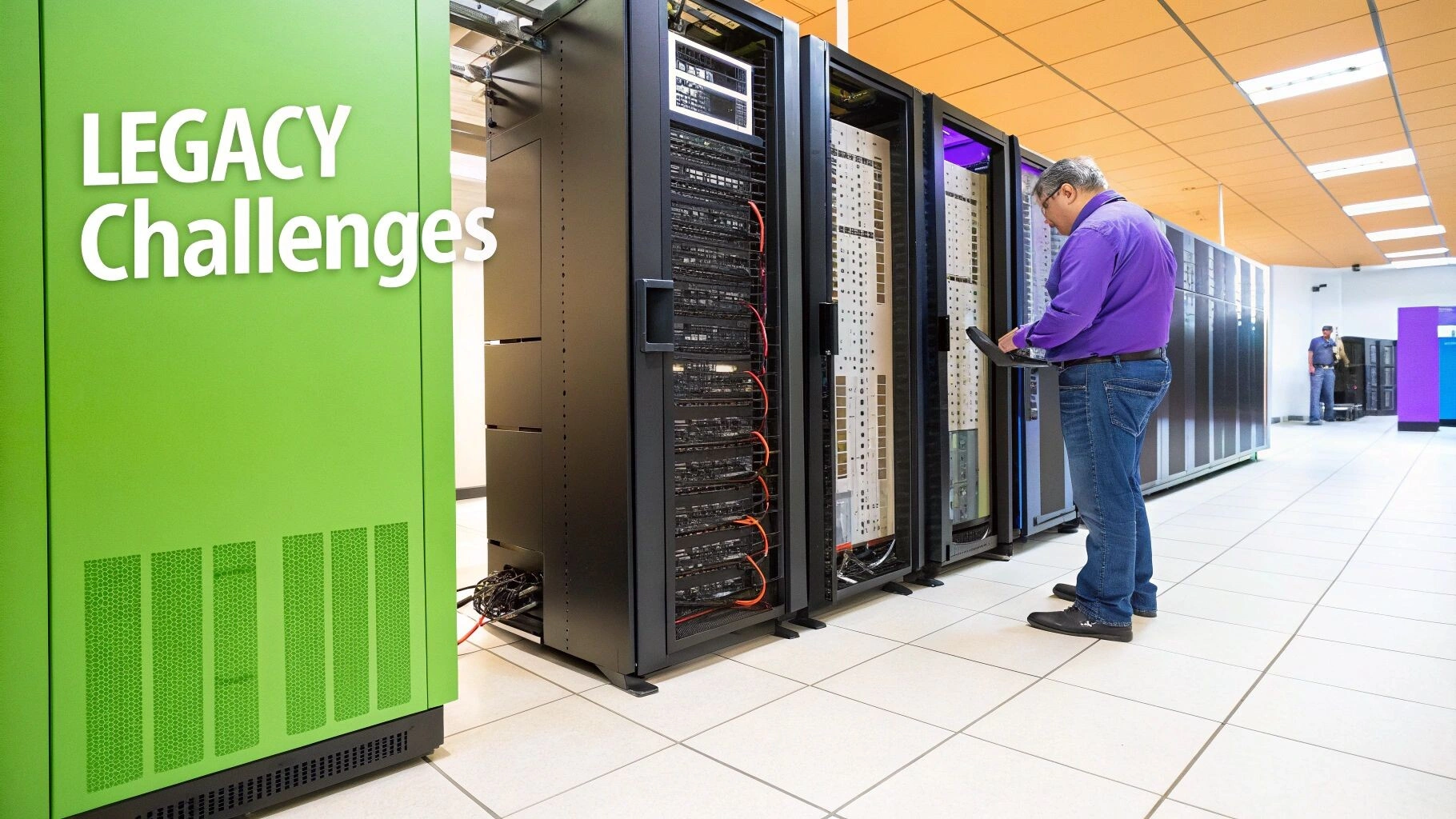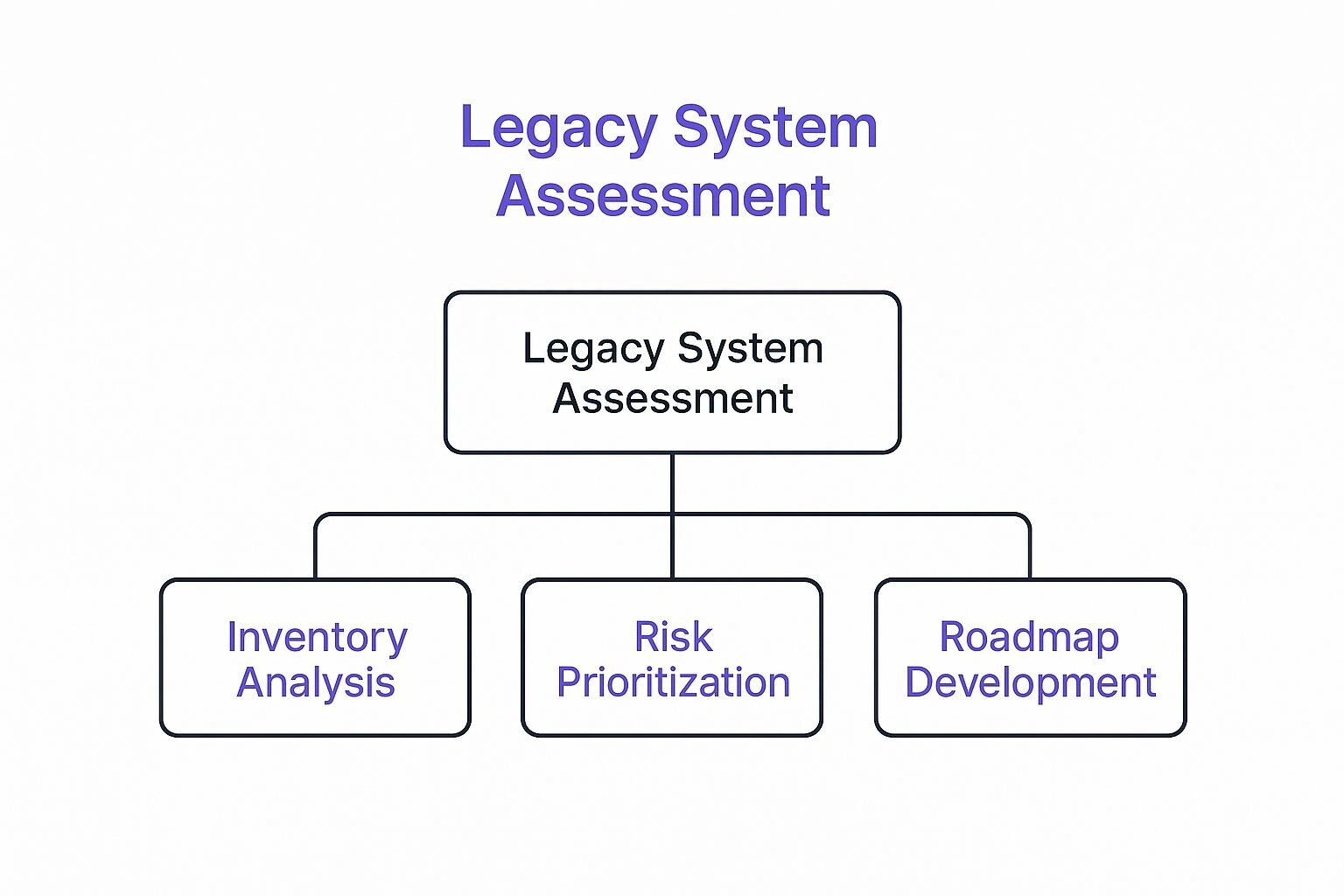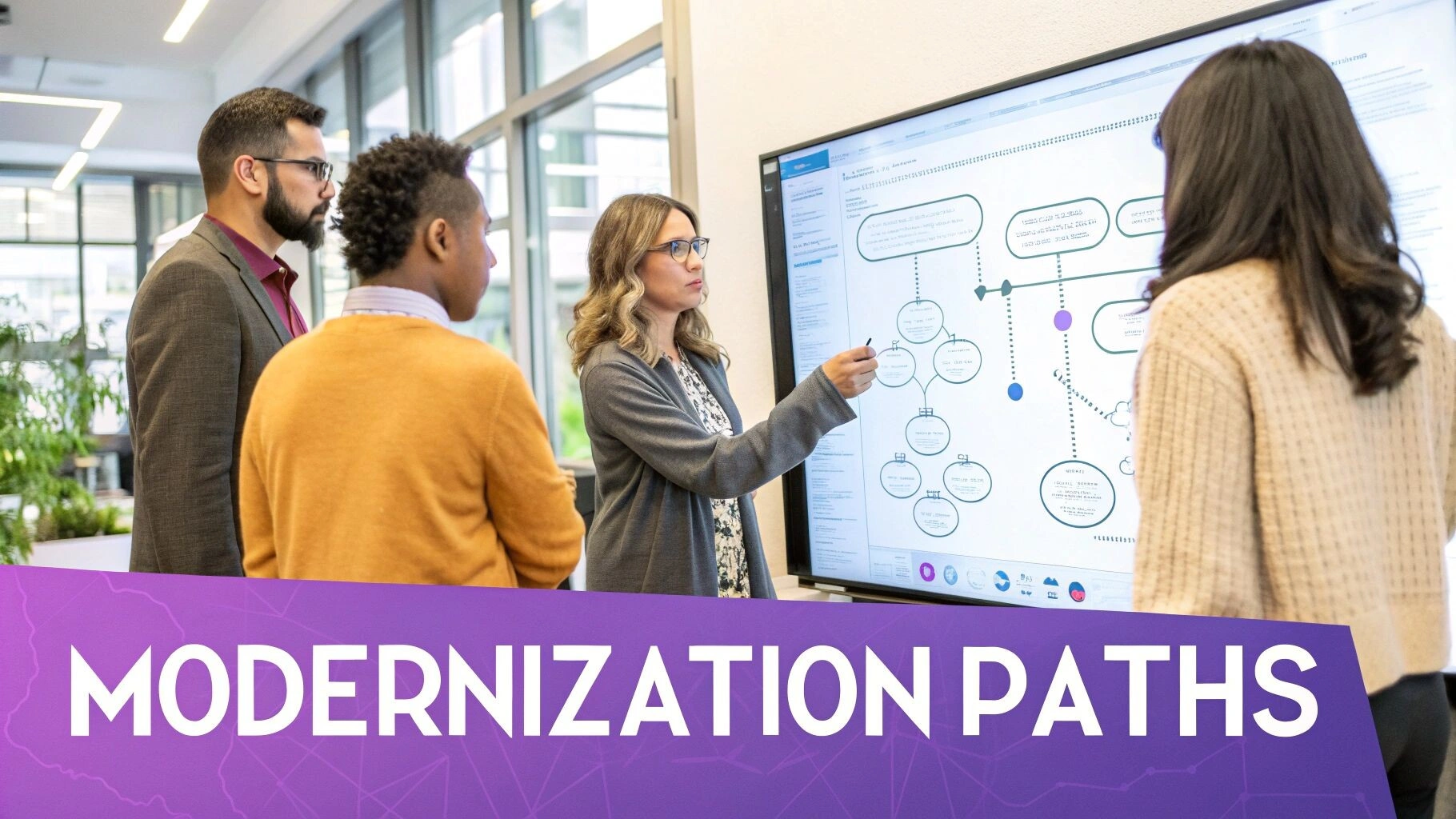Modernising Legacy Systems for Business Growth
Discover proven strategies for modernising legacy systems. This guide unpacks key approaches, benefits, and ROI to drive your digital transformation.

When we talk about modernising legacy systems, we’re essentially talking about renovating a critical part of your business’s foundation. It’s the process of upgrading or replacing outdated IT infrastructure to boost efficiency, tighten up security, and sharpen your competitive edge. This isn’t just a tech upgrade; it’s about future-proofing your operations against the risks of technological decay.
Why Modernising Legacy Systems Is Non-Negotiable
Think of your core business system as an old, dependable car. It’s gotten you this far, but it guzzles fuel, lacks modern safety features like airbags, and finding parts has become a costly scavenger hunt. This is the exact predicament many organisations find themselves in—relying on outdated software and hardware that now act as a brake on progress.
Putting off modernisation isn’t a cost-saving measure; it’s an accumulation of risk. These old systems often become a huge financial drain. Maintenance costs spiral upwards as the technology ages, and performance inevitably degrades, leading to sluggish operations that frustrate employees and customers alike.
The Hidden Costs of Inaction
The most immediate pain points are usually operational. Simple tasks become clunky and time-consuming. Integrating with modern tools like cloud services or APIs is either a nightmare or completely impossible. And as the business grows, the system just can’t keep up. This creates a nasty cycle of inefficiency where your teams spend more time wrestling with system limitations than creating value.
Beyond the performance hit, the security risks are alarming. Legacy systems are a prime target for cyber-attacks because vendors have often stopped releasing security patches, leaving them riddled with known, unfixable vulnerabilities. A single breach can be catastrophic, leading to massive data loss, reputational ruin, and severe financial penalties that dwarf the cost of a planned upgrade. For a deeper dive into this journey, you can explore our complete guide to legacy system modernisation.
The Looming Skills Gap
There’s another critical threat that often flies under the radar: the dwindling talent pool. The developers and engineers who built and intimately understood these systems are retiring, and they’re taking their invaluable institutional knowledge with them. This is creating a dangerous skills gap where very few experts are left who can manage or fix these critical platforms.
This isn’t just a private sector problem; it’s a massive challenge across the board. In Australia, over 71% of government entities depend on legacy technologies, with more than 800 public service employees dedicated solely to keeping them running. To make matters worse, over 20% of the public sector’s digital workforce is over 55 and nearing retirement. This poses a significant risk for systems built on older programming languages like COBOL. You can learn more about these workforce challenges from the Australian Government’s Data and Digital Office findings.
Modernising legacy systems isn’t merely an IT project; it’s a strategic business imperative. It’s about shifting from a defensive, maintenance-focused posture to an offensive strategy that enables innovation, agility, and long-term resilience.
Ultimately, clinging to outdated technology is a gamble against time. The question is no longer if your legacy system will fail, but when. Proactively modernising is the only sensible way to de-risk your operations, unlock new capabilities, and secure a competitive footing for years to come.
The Tipping Point: What Pushes Businesses to Modernise?

Very few organisations wake up one day and decide to overhaul their core systems on a whim. The decision is almost always a slow burn, a gradual build-up of pressures until the risk of standing still becomes far scarier than the cost of moving forward.
These catalysts typically fall into two camps: business drivers and technical drivers. Think of them as two sides of the same coin. On one side, the business feels the pain of lost market share and unhappy customers. On the other, the tech team is stuck fighting fires, dealing with constant system failures and a dwindling pool of people who even know how to maintain the old code. To get buy-in for modernising legacy systems, you need to speak to both.
Business Drivers: The Pains You See on the P&L
Often, the most powerful push for modernisation comes from outside the IT department. These are the commercial realities that directly hit the bottom line, making them impossible for the C-suite to ignore.
- Shifting Customer Expectations: Today’s customers expect everything to be seamless, instant, and tailored to them. A clunky, slow legacy system just can’t deliver that kind of experience, which inevitably leads to frustrated users and a damaged reputation.
- Losing to Agile Competitors: While you’re stuck with old tech, your competitors are rolling out new features and adapting to market changes in weeks, not years. An outdated system handcuffs your ability to innovate, essentially forcing you to watch from the sidelines as others capture the market.
- The Weight of Compliance: Regulations around data security and privacy are constantly evolving. Many legacy platforms were never built for today’s compliance landscape, making it difficult and expensive to adapt. This exposes the business to serious legal risks and hefty fines.
When these pressures mount, the story becomes clear: the current system isn’t just an inconvenience; it’s actively holding the business back.
Technical Drivers: The Rot from Within
While business drivers are the external threats, technical drivers are the signs of internal decay. These issues create a constant drain on your team’s time, budget, and morale. Perhaps the biggest culprit is the crushing weight of technical debt. For anyone facing this, it’s crucial to explore solid strategies for managing technical debt before it stifles all innovation.
The real problem with legacy systems isn’t just that they’re old; it’s that their complexity and fragility create a state of constant firefighting, leaving no room for strategic innovation or forward progress.
Beyond debt, other technical alarms are ringing loud and clear. Maintenance costs for obsolete hardware and software can eat up a staggering 80% of an IT budget, leaving almost nothing for projects that could actually grow the business. Plus, the lack of modern API support turns what should be a simple integration with a new SaaS tool into a complex, custom-coded mess.
This isn’t just a niche problem; it’s a national priority. The Australian Government has flagged legacy system modernisation as a key part of its digital strategy. As of 2025, there are 110 major federal digital projects underway with a collective budget of $12.9 billion AUD. A significant portion of that funding is earmarked specifically for replacing outdated IT infrastructure.
When both the business and technical pressures align, the argument for modernisation is no longer a question of if, but when.
Choosing Your Modernisation Approach
So, you’ve made the call: your legacy systems need an upgrade. That’s the first step. The next, and arguably more critical, decision is how you’re going to do it. There’s no one-size-fits-all answer here. The best strategy is always a reflection of your unique system, budget, risk tolerance, and what you’re trying to achieve as a business.
https://www.youtube.com/embed/x9Yb27J9wIc
This is where the well-known ‘7 Rs of Modernisation’ come in. They provide a practical framework to guide your thinking.
Think of it like dealing with an old, but still essential, family home. Do you simply move it to a better block of land (Rehost)? Do you keep the structure but give the kitchen and bathrooms a major renovation (Refactor)? Or is it time to knock it down and build a brand-new house from the ground up (Rebuild)? Each path comes with its own set of trade-offs in cost, effort, and the final result.
Foundational Strategies: The Quick Wins
Let’s start with the strategies that are generally the fastest and least disruptive. These focus on moving your application or making small tweaks without getting into a major rewrite of its core logic.
-
Rehost (Lift and Shift): This is the most straightforward approach, much like packing up your furniture and moving it into a new house. You redeploy the application to a new infrastructure—usually the cloud—with minimal, if any, code changes. The big win here is speed and lower upfront costs, but it won’t fix any underlying architectural issues.
-
Replatform (Lift and Reshape): This is a step up. Imagine moving house but also taking the opportunity to upgrade your old appliances. You shift your application to the cloud but also make some small optimisations to benefit from cloud-native features, like swapping a self-managed database for a fully managed service.
-
Repurchase (Drop and Shop): Sometimes, it’s best to stop maintaining your own custom solution altogether. This strategy involves retiring your old system and replacing it with a commercial Software-as-a-Service (SaaS) product. If a market leader like Salesforce or Xero does what your legacy system does, repurchasing can be a fast track to modern functionality.
These foundational approaches are great for quickly cutting infrastructure costs and reducing the maintenance burden. However, they might not deliver the deeper, more fundamental improvements your business truly needs.
Choosing a modernisation path isn’t just a technical decision; it’s a strategic one. The right choice aligns the technical effort with the desired business value, ensuring the investment delivers a meaningful return.
A proper legacy system assessment is the critical first step, helping you map out the path forward with clarity.

As this shows, before you can even think about a roadmap, you have to perform a thorough analysis of what you have and prioritise the risks involved.
Transformational Strategies: The Deep Overhauls
When quick wins aren’t enough, you need to roll up your sleeves. These more intensive strategies involve changing the application’s code and architecture. They demand a much bigger investment, but the payoff in long-term benefits is usually far greater.
-
Refactor: Think of this as a major renovation that doesn’t change the floor plan of your house. You’re restructuring and optimising existing code to improve things like performance or security, but you aren’t changing what the application actually does. It’s a fantastic way to pay down technical debt and make the system easier to work with in the future.
-
Rearchitect: This is where you make significant changes to the application’s code to shift it to a new, more capable architecture—like breaking down a monolith into microservices. It’s a major undertaking, but it unlocks the ability to scale more effectively, improve performance, and boost developer productivity.
-
Rebuild: This is the most intensive option short of starting from scratch with a brand-new product. You rewrite a specific application component from the ground up, keeping its original purpose and features. You’d go down this path when the existing code is simply unsalvageable, but no off-the-shelf alternative exists.
The Final ‘R’: Knowing When to Let Go
Finally, there’s one more option every organisation has to consider, and it’s often overlooked.
- Retire: Sometimes, the smartest move is to simply decommission the system entirely. If an application no longer provides real business value or its functions have been absorbed by other, newer systems, the best course of action is to turn it off for good. This immediately eliminates all its associated running costs and frees up your team to focus on what really matters.
Comparing Legacy Modernisation Strategies
To help you visualise the trade-offs, here’s a breakdown of the seven strategies. This table compares them based on their typical cost, risk, effort, and potential business impact.
| Strategy | Analogy | Typical Cost | Risk Level | Business Impact |
|---|---|---|---|---|
| Rehost | Moving to a new house | Low | Low | Low to Moderate |
| Replatform | Moving & upgrading appliances | Low to Moderate | Low to Moderate | Moderate |
| Repurchase | Buying a new house | Moderate | Low to Moderate | High |
| Refactor | Major home renovation | Moderate | Moderate | Moderate to High |
| Rearchitect | Changing the floor plan | High | High | High |
| Rebuild | Knocking down & rebuilding | Very High | Very High | Very High |
| Retire | Selling the house | Very Low | Low | Varies |
Choosing wisely from these seven options is the cornerstone of any successful modernisation project. It demands a clear-eyed assessment of your technology and a frank evaluation of your business goals to strike that perfect balance between risk and reward.
How to Navigate Common Modernisation Pitfalls

Embarking on a modernisation project can feel like navigating a minefield. The goal—a faster, more secure, and efficient system—is crystal clear, but the path is littered with hidden dangers that can derail even the best-laid plans. Knowing what these common pitfalls are is the first step to avoiding them.
One of the biggest culprits is the sheer weight of accumulated technical debt. This is far more than just messy code. It’s a tangled web of undocumented shortcuts, obsolete components, and fragile logic that makes every single change a high-stakes gamble. You can’t just promise to “clean it up later”; you need a deliberate strategy from day one.
Then there’s the talent gap. The developers who intimately understand old languages like COBOL or the quirks of ancient database architectures are becoming a rare breed. Finding the right people to keep the old system running while simultaneously building its replacement can become a huge bottleneck, dragging out timelines and driving up costs.
Managing Scope and Stakeholder Expectations
It’s a classic story: the project starts with a clear goal but slowly morphs into an uncontrollable beast. This is scope creep, and it’s a project killer. It’s why defining project scope effectively is so critical from the very beginning. Without strict boundaries, a simple “database update” can spiral into a full-scale rebuild of unrelated systems, completely blowing the budget and schedule.
Just as important is managing expectations through honest, continuous communication. Business leaders need to grasp that modernising legacy systems isn’t a quick fix. It’s a complex, marathon-like effort filled with inherent risks. Being upfront about timelines, potential disruptions, and the long-term payoff is crucial for maintaining support and preventing disillusionment down the track.
The success of a modernisation project is often determined before a single line of new code is written. It hinges on realistic planning, transparent communication, and a clear understanding of the obstacles ahead.
These projects have a notoriously difficult reputation for a reason. It’s reported that a staggering 74% of legacy system modernisation projects globally and in Australia fail to reach completion. The main causes—talent shortages, crippling technical debt, and sky-high costs—underscore the complexity involved.
Mitigating Disruption and Ensuring Business Continuity
The biggest fear for any business is, of course, disrupting daily operations. A “big bang” migration—where you flick a switch to turn off the old system and turn on the new one—is incredibly risky. If the new system stumbles, rolling back is often a nightmare, leading to catastrophic downtime and lost revenue.
A much safer and saner strategy is a phased rollout. Here are a few proven approaches to consider:
- The Strangler Fig Pattern: Imagine a vine growing over and eventually replacing an old structure. You build new services around the edges of the legacy system, and over time, they gradually “strangle” the old functionality until it’s no longer needed.
- Parallel Run: For a set period, you run both the old and new systems at the same time. This allows you to directly compare outputs and validate that the new system is working perfectly before you decommission the old one.
- Component-Based Rollout: Instead of replacing everything at once, you migrate the system piece by piece. You might start with the user authentication module, then move on to inventory management, and so on, making the process far more manageable.
Keeping the business running smoothly also means being meticulous about your integrations. As you introduce new, modern components, you have to ensure they can talk to the remaining legacy parts without a hitch. Our guide on https://osher.com.au/blog/system-integration-best-practices/ provides some great frameworks for tackling this challenge.
By anticipating these issues—from technical debt and talent gaps to scope creep and operational chaos—you can build a proactive plan. Being forewarned really is being forearmed, allowing you to steer your modernisation project clear of the common traps and toward a successful, resilient future.
A Blueprint for Successful Modernisation
Moving from theory to a real-world project needs a clear, strategic blueprint. Successful legacy system modernisation projects are never just happy accidents. They’re the result of meticulous planning, strong leadership, and a deep understanding of both the technology and the people involved in the change. This is how you execute a smoother, more effective transition.
The journey kicks off with an honest, thorough audit of your existing systems. It’s simple: you can’t modernise what you don’t truly understand. This has to go far beyond a simple inventory of hardware and software. You need to map out data flows, pinpoint all the interdependencies, and document the specific business processes that lean on the old platform. This foundational step is non-negotiable; it’s what a realistic plan is built on.
Laying the Groundwork for Change
Once you have a clear picture of the current state, you need to define what success actually looks like. This means setting clear, measurable Key Performance Indicators (KPIs) that are directly tied to your business drivers. These aren’t just technical metrics; they should reflect tangible business outcomes.
For example, your KPIs might aim to:
- Reduce average system response time by 30%.
- Lower annual maintenance and operational costs by 40%.
- Cut the time to develop and launch new features from months down to weeks.
- Improve the customer satisfaction score for all digital interactions.
With clear goals defined, the focus shifts to building the right team and securing unwavering support. A modernisation project can’t just be an IT-only initiative. It absolutely demands strong executive sponsorship to champion the vision, secure the budget, and navigate the inevitable organisational politics.
It also requires genuine collaboration across departments. Bringing in stakeholders from finance, operations, and marketing right from the start ensures the new system will meet their real-world needs and helps build a sense of shared ownership. This collaborative spirit is vital for managing the human side of the change.
Executing with Precision and Care
With your team, goals, and sponsorship locked in, it’s time to start executing. One of the most critical decisions you’ll make is your rollout strategy. A “big bang” launch—switching everything over at once—might sound appealingly fast, but it carries an immense amount of risk. A single unforeseen problem can trigger catastrophic downtime and completely erode stakeholder confidence.
A far more prudent approach is an incremental migration. This is where methods like the Strangler Fig Pattern really shine. The idea is to gradually build new services around the old system, routing traffic to them piece by piece. Over time, the new system grows and eventually “strangles” the legacy platform until it can be safely switched off. You can explore a detailed breakdown of this and other migration approaches in our guide to crafting a legacy system migration strategy that actually works.
The most successful modernisation projects are not sprints; they are carefully orchestrated marathons. They prioritise risk mitigation and business continuity over raw speed, ensuring a stable transition that delivers lasting value.
This incremental approach for modernising legacy systems makes the entire process far more manageable. It reduces risk and allows your team to learn and adapt as they go. It also creates opportunities to gather user feedback on smaller components and make adjustments before the full-scale rollout, ensuring the final product aligns perfectly with what the business actually needs.
By combining a comprehensive audit, clear KPIs, strong collaboration, and a phased execution, you create a robust blueprint for success.
Calculating the Real ROI of Your Project

Getting a large-scale modernisation project over the line isn’t just a matter of showing a simple cost-benefit analysis. You need to build a rock-solid business case that clearly spells out the return on investment (ROI). This means thinking beyond the immediate savings and painting a full picture of the benefits—both the easily measured and the less obvious ones—to justify what can be a significant upfront cost.
A well-crafted ROI calculation is what gets you the executive sign-off. It re-frames the project from a hefty IT expense into a strategic move that will deliver real, measurable growth for the business.
Measuring Tangible Gains
The most direct part of any ROI calculation is tallying up the tangible, hard-dollar savings. These are the financial wins you can point to on a balance sheet. The objective here is simple: show how modernising legacy systems will concretely lower your operational expenses.
Start with your current maintenance bills. Think about those expensive support contracts for hardware that’s seen better days, the licensing fees for software that’s no longer fit for purpose, and the salaries for specialist developers who are becoming rarer and more expensive to keep.
Then, look at your infrastructure costs. Many legacy systems are still chugging away on inefficient, on-premise servers that chew up a lot of power and take up valuable physical space. Shifting to a modern cloud setup can slash these overheads, often by more than 50%.
Quantifying Intangible Value
While the hard savings are a great start, the real game-changer in modernisation often comes from the intangible benefits. These gains are trickier to put a number on, but their impact on long-term business health is immense. You could even think of them as the opportunity cost of sticking with the status quo.
Let’s break down some of these critical advantages:
- Enhanced Security: What’s the real cost of a single data breach? Consider the regulatory fines, the hit to your reputation, and the customers you’d lose. Modern systems with up-to-date security features drastically minimise this risk.
- Improved Developer Productivity: When your developers aren’t wrestling with brittle, undocumented code, they can actually focus on building new things. This speeds up your time-to-market for new products and features, giving you a real competitive advantage.
- Talent Attraction and Retention: The best people in tech want to work with modern tools and architectures. An updated tech stack makes your company a far more appealing workplace, which boosts morale and cuts down on expensive staff turnover.
To make your case truly compelling, try to assign a financial value to these intangibles. For example, what’s the revenue boost from getting a new product out three months before your competitor? What are the savings from a 15% drop in developer turnover?
By presenting a complete picture of both the hard savings and the strategic value, you create a powerful narrative. This detailed ROI framework proves that modernising your legacy systems isn’t just about trimming the fat; it’s a necessary investment in the future agility, security, and competitiveness of your entire organisation.
Answering Your Top Modernisation Questions
Even with a solid strategy in place, kicking off a project to modernise your legacy systems is bound to raise some tough questions. It’s completely normal. Tackling these concerns upfront is the best way to build the confidence your team needs to move forward without second-guessing every decision.
Let’s break down a few of the most common questions we hear from organisations just starting this journey.
How Long Should a Modernisation Project Realistically Take?
There’s no one-size-fits-all answer here; the timeline really hinges on your system’s complexity and the strategy you choose. A straightforward Rehost – what many call a “lift and shift” to the cloud – might be wrapped up in just a few months.
On the other hand, a full Rebuild or a deep Rearchitect of a critical enterprise platform is a much bigger deal. We’re talking about a significant undertaking that could easily stretch over several years.
A major influence on your timeline is how you launch. A “big bang” release, where everything goes live at once, is incredibly risky. A phased rollout, while longer on paper, starts delivering value much sooner and dramatically lowers the risk of something going wrong and disrupting the business. The trick is to base your timeline on a detailed system audit, not wishful thinking.
How Do I Select the Right Modernisation Partner?
Frankly, choosing the right partner is just as critical as choosing the right modernisation strategy. You need a team that can show you, not just tell you, they have experience in your industry and with the specific technologies you’re moving from and to. Their skills have to be broader than just writing code; they need a genuine grasp of business process analysis and how to manage organisational change.
A great partner doesn’t just build what you ask for. They challenge your assumptions and help you discover the most effective path to achieving your business outcomes. They act as strategic advisors, not just order-takers.
Always ask for detailed case studies from projects of a similar size and complexity. Don’t be shy about checking their client references and make sure their communication style fits your company culture. This is going to be a close, long-term relationship, so a good cultural fit and open, honest communication are non-negotiable.
Where Do We Even Begin?
The best place to start is always with a thorough assessment. You simply can’t decide on the road ahead until you have a perfectly clear picture of where you are right now.
This means getting into the weeds and:
- Mapping Dependencies: Documenting every single connection between the old system and everything else it talks to.
- Analysing Business Processes: Pinpointing exactly which business functions depend on the system to operate.
- Evaluating Technical Debt: Putting a number on the scale of outdated code, architectural shortcuts, and other issues holding you back.
This initial audit gives you the hard data needed to make every decision that follows. It shines a light on which parts of the system are causing the most pain and which offer the biggest rewards, allowing you to prioritise your efforts and build an undeniable business case for the project.
Navigating the complexities of modernising legacy systems requires a partner who understands both technology and business strategy. Osher Digital specialises in helping organisations assess their current state, define a clear roadmap, and execute a modernisation plan that minimises risk and maximises ROI. Learn how we can help you unlock new efficiencies.
Jump to a section
Ready to streamline your operations?
Get in touch for a free consultation to see how we can streamline your operations and increase your productivity.